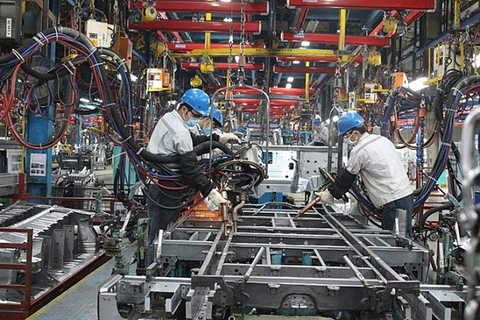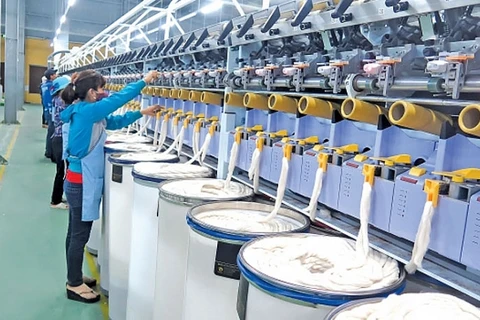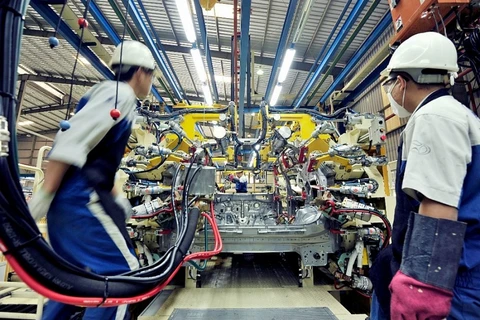 Supporting industries, a sector prioritised for investment and development in Vietnam, is facing a host of shortcomings and new issues (Photo: baodautu.vn)
Supporting industries, a sector prioritised for investment and development in Vietnam, is facing a host of shortcomings and new issues (Photo: baodautu.vn) In the recent time, the sector has seen its connectivity and supply chains strengthened, gradually forming its ecosystem and increasing the localisation rate.
In 2020, Vietnam stepped up its programme on support industries development to help firms boost their production and business capacity and gain opportunities to join global production chains. Meanwhile, many multinational manufacturing groups planned to invest in Vietnam or expand their existing projects in the market.
However, the sector’s growth remains slow and has yet to meet demand from domestic for-export industries, hence a low localisation rate and value added of domestically-produced products.
In recent years, manufacturing and processing industries contributed nearly 40 percent of the economy's total production and business revenue, but only accounted for about 14 percent of the GDP. Their value added was much lower than that of other industries.
In addition, due to the weak growth of supporting industries, the manufacturing and processing sector relies heavily on imported materials and components. As a result, when COVID-19 broke out, they faced various challenges to ensure their production inputs. The pandemic has triggered a constant shortage of materials along with difficulties and congested delivery of finished products.
To boost the development of supporting industries, it is necessary to ensure the market and the purchasing power of consumers; as well as to improve domestic production capacity and the quality of vocational training. Therefore, insiders said there is a need to early revise problematic regulations in related development policies, and devise solutions for enterprises to boost their financial capacity. Supporting industries should continue to be considered a priority area.
The Government issued a resolution last year on measures to further propel supporting industries, setting out development goals for the next decade.
Accordingly, Vietnamese enterprises are to be able to produce highly-competitive support products, meeting 45 percent of essential needs for domestic production and consumption and accounting for about 11 percent of industrial production value by 2025.
The country should have about 1,000 enterprises capable of directly supplying for assembly enterprises and multinational corporations operating in Vietnam, with domestic enterprises to account for about 30 percent by 2025.
By 2030, locally-made support products should meet 70 percent of domestic demand and account for about 14 percent of industrial production value. Some 2,000 companies are to be capable of supplying directly to assemblers and multinational corporations by 2030.
To implement the resolution, the Ministry of Industry and Trade has identified that the development of supporting industries will follow the direction of selecting fields that require investment suitable to different periods. It also chose a number of key industries such as auto, electronics, garment and textile, and leather and footwear.
In a report submitted to the National Assembly Standing Committee and legislators early this year, the Government cited statistics showing that companies in supporting industries account for nearly 4.5 percent of all manufacturing and processing businesses and have created more than 600,000 jobs, equivalent to 8 percent of the workforce in the manufacturing and processing sector. Their net revenue now tops 900 trillion VND (38.9 billion USD), or about 11 percent of the sector’s total.
Some Vietnamese enterprises boast relatively good capacity in producing moulds, bicycle and motorbike components, electrical cables, plastic and rubber components, and tyres, meeting domestic demand and the requirements of foreign importers.
The report noted that supporting industries play a decisive role in restructuring the economy, improving workplace productivity and skills, and promoting the competitiveness and quality of Vietnamese goods and the economy./.
The Government issued a resolution last year on measures to further propel supporting industries, setting out development goals for the next decade.
Accordingly, Vietnamese enterprises are to be able to produce highly-competitive support products, meeting 45 percent of essential needs for domestic production and consumption and accounting for about 11 percent of industrial production value by 2025.
The country should have about 1,000 enterprises capable of directly supplying for assembly enterprises and multinational corporations operating in Vietnam, with domestic enterprises to account for about 30 percent by 2025.
By 2030, locally-made support products should meet 70 percent of domestic demand and account for about 14 percent of industrial production value. Some 2,000 companies are to be capable of supplying directly to assemblers and multinational corporations by 2030.
To implement the resolution, the Ministry of Industry and Trade has identified that the development of supporting industries will follow the direction of selecting fields that require investment suitable to different periods. It also chose a number of key industries such as auto, electronics, garment and textile, and leather and footwear.
In a report submitted to the National Assembly Standing Committee and legislators early this year, the Government cited statistics showing that companies in supporting industries account for nearly 4.5 percent of all manufacturing and processing businesses and have created more than 600,000 jobs, equivalent to 8 percent of the workforce in the manufacturing and processing sector. Their net revenue now tops 900 trillion VND (38.9 billion USD), or about 11 percent of the sector’s total.
Some Vietnamese enterprises boast relatively good capacity in producing moulds, bicycle and motorbike components, electrical cables, plastic and rubber components, and tyres, meeting domestic demand and the requirements of foreign importers.
The report noted that supporting industries play a decisive role in restructuring the economy, improving workplace productivity and skills, and promoting the competitiveness and quality of Vietnamese goods and the economy./.
VNA
























